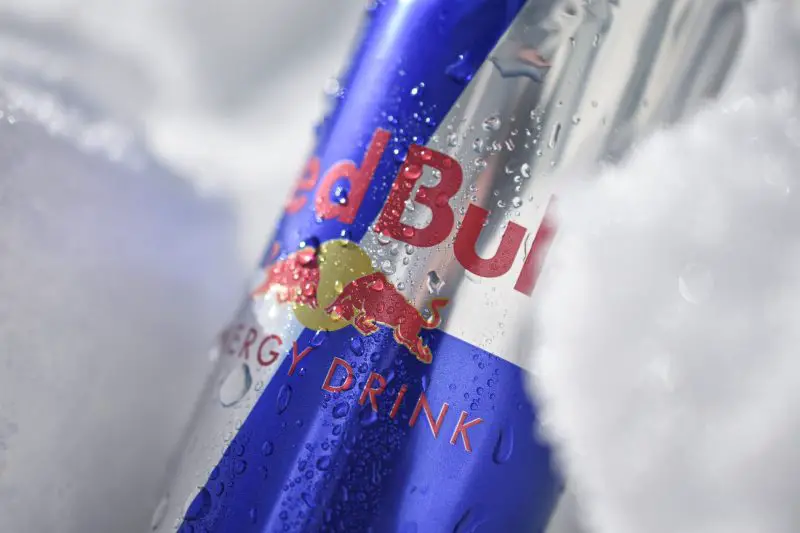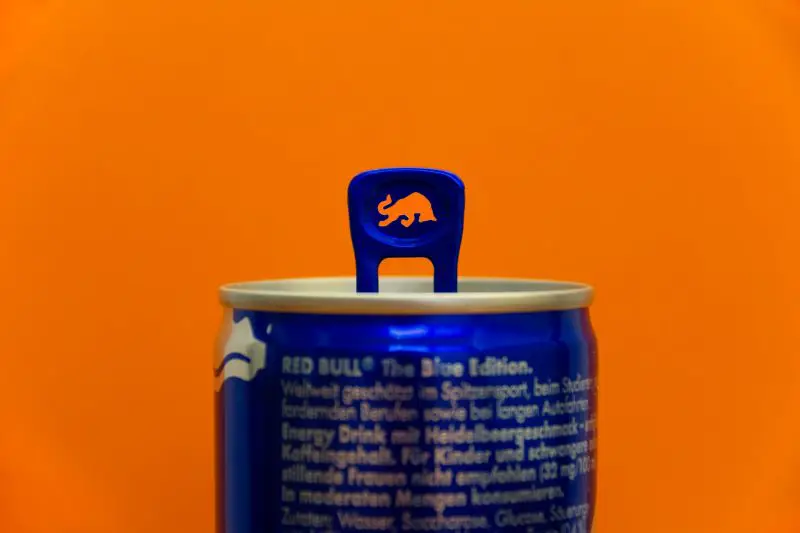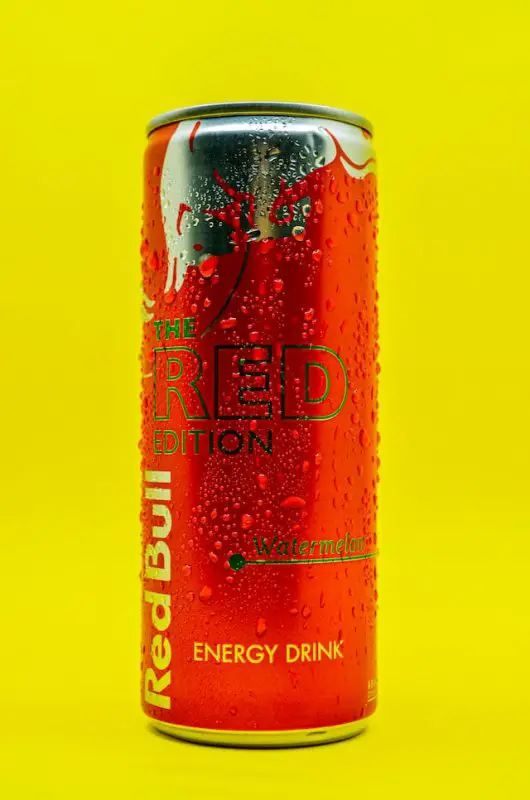For an energy drink that doesn’t do well in taste tests, with unpatented contents and all ingredients listed outside its slim silver can, and not manufactured by its own company, Red Bull has defied conventional business wisdom and captured the imagination (and pockets) of millions of people.
As of 2021, Red Bull has sold 9.8 billion cans in more than 170 countries.
It goes without saying that when you go against the grain and surprise people with your moves, people will invent stories and build up myths about you. Here are 7 facts about Red Bull to set the record straight.
How many sizes does Red Bull have?
Red Bull comes in 4 sizes but many think it’s 3. Red Bull can sizes have the following can dimensions:
- 8.4 fluid oz. (250 ml.) can at 2.12 x 4.74 inches (53 x 121 mm.)
- 12 fluid oz. (355 ml.) can at 2.25 x 6.125 inches (57 x 156 mm.)
- 16 fluid oz. (473 ml.) can at 2.38 x 7.12 inches (60 x 181 mm.)
- 20 fluid oz. (591 ml.) can at 10.75 x 7.75 inches (273 x 197 mm.)
In some countries like the Philippines, Red Bull also comes in 150ml (5.07 fluid oz.) and 250 ml. (8.45 fluid.oz.) glass bottles. In Australia, there is the 330 ml. (11.16 fluid. oz.) aluminum bottle.

Why does Red Bull use tall and slim cans?
Compared to soda cans which come in 12-fluid oz. sizes (4.83 x 2.6 inches or 123 x 66 mm.), Red Bull cans are tall and slim because they take up less shelf space without sacrificing the content amount, so retailers can stock more cans per shelf.
They also take less energy. Large surface areas cool down more quickly. With taller and slimmer cans, Red Bull stays cooler, longer.
Taller and slimmer cans are perceived as “sexier”, too, which ties right in with Red Bull’s target market profile of “young, urban males that live on the edge or aspire to do so.”
What is the smallest size Red Bull can?
The smallest-sized Red Bull can was that of the 2.03-fluid. oz. (60 ml.) Red Bull Shot which was produced in 2009. However, Red Bull discontinued its production, along with Red Bull Cola, in 2011. It has now become a collector’s item among Red Bull fans.
According to avid Red Bull fans, although they were featured as uncarbonated drinks, Red Bull Energy Shots were sold warm and not as appetizing as the cold Red Bulls people have gotten used to. They were also not priced low enough. Although Red Bull is considered a luxury item in energy drinks, it’s not in the shot market.
Still, it was the no. 3 best-selling energy shots in convenience stores in 2010. The company decided to discontinue production, though, to focus on its core energy drink market.
What is the largest size Red Bull can?
The 20-fluid oz. (591 ml.) Red Bull Energy Drink can is the largest size Red Bull can. It contains around 190 mg or 20ml of caffeine, equivalent to the amount of caffeine in 2 and a half cups of coffee.
The standard Red Bull can (250 ml. or 8.4 fluid oz.) contains 80 mg. of caffeine, which is the same amount of caffeine in a regular cup of coffee.
What are all the Red Bull flavors?
There are 3 Red Bull variants that come in 6 Red Bull Edition flavors in the market today.

The 3 Red Bull variants are:
- Red Bull Energy Drink (standard)
- Red Bull Zero
- Red Bull Sugar-free
Both Red Bull Zero and Red Bull Sugar-free contain the same main ingredients and low-calorie sweeteners but differ only in taste. Sugar-free Red Bull is lower in sugar and calories.
The Edition flavors are:
- Blueberry
- Coconut Berry
- Peach Nectarine
- Pomegranate
- Tropical
- Watermelon

Other flavors are often released seasonally but the Edition flavors have become Red Bull’s year-round collection.
Does Red Bull have alcohol?
No. The main ingredients in a Red Bull are taurine, caffeine, sugar, glucose syrup, and some B-group vitamins. Red Bull is a non-alcoholic energy drink.
However, bartenders have taken to mixing Red Bull with vodka or Jager which have become one of the hottest drinks in bars today, sold at between $10 to $16.
The Centers for Disease Control and Prevention (CDC) warns against mixing alcohol with caffeine. The depressant effects of alcohol can be masked by the stimulating effects of caffeine. This can make drinkers feel more alert than they would otherwise, so it can result in their drinking more alcohol and becoming more weakened than they realize.
How much sugar is in Red Bull?
According to its official website, a standard 8.4 fluid oz. (250 ml.) of Red Bull contains 27 grams of sugar, roughly equivalent to the amount of sugar in a glass of apple or orange juice, which contains 22 to 28 grams.
A 12 fluid oz. (355 ml.) Red Bull contains 38 grams of sugar. At 4 calories per gram of sugar, this translates to 156 calories.
A 16-fluid oz. (473 ml.) Red Bull contains 50 grams of sugar (212 calories), while a 20-fluid-oz. (591 ml.) Red Bull has 63 grams of sugar (252 calories).
Sugar-free Red Bull in 20 fluid oz. has, of course, zero sugar, with a net carbohydrate amount of 5 grams equivalent to 30 calories. Net carbohydrates are the carbohydrates in food that you can digest and use for energy.
The American Heart Association recommends that sugar intake should be less than 10% of total daily calories as part of a healthy diet. A 2,500-calorie recommended daily diet for men and a 2,000-calorie daily diet for women would mean that men should have their daily sugar intake capped at 250 calories and women at 200 calories.
This means that drinking a standard 8.4 fluid oz. (250 ml.) can of Red Bull already provides a person with 108 calories, which is 43% of the maximum daily recommended sugar intake for men and 50% for women.
When did Red Bull become popular in the US?
Red Bull is famous for challenging conventional thinking and norms, which appeals to its target market of young, urban males living on the edge and being free. It exploded into popularity as soon as it hit the United States in 1997.
Starting in 1984, Red Bull’s founder, Austrian Dietrich Mateschitz, worked on Red Bull’s formula, brand positioning, packaging, and marketing concept for 3 years. On April 1, 1987, Red Bull Energy Drink was launched in Austria creating a new product category: energy drinks.
From the get-go, Red Bull challenged conventional practices in beverage manufacturing and marketing. It outsources 100% of its manufacturing and concentrates on marketing.
Using “buzz marketing” as a key strategy, Red Bull herds consumers to exclusive and exciting events that get high media coverage. Mateschitz explains, “We don’t bring the product to the consumer, we bring consumers to the product.”
Since it started, it concentrated on nightclubs and the student market. In Europe, it hired students to drive Minis with a big Red Bull can strapped on top, cruising around campuses and offering free samples at events and parties.
The student marketing buzz boosted sales so much that by the year 2000, Red Bull’s sales in England soared to 200 million cans, close to matching its German sales.
In a couple of years, Mateschitz developed the idea of getting consumers to flock to events where extreme sports athletes perform incredible acts that leave audiences stunned and gasping for more adrenalin rush to keep them going.
Red Bull has sponsored events like air acrobatics, rail-sliding, mountain bike free ride competitions, motocross freestyle rallies, street luge (including jumps of up to 94 feet), surfing a 25-foot tidal bore for 34 minutes on the Amazon River, and many more.
Red Bull also supports close to 500 world-class extreme sports athletes in spectacular and often record-breaking events all over the world. Additionally, Red Bull launched its Taurus World Stunt Awards Foundation to support stunt performers in need.
Today, Red Bull’s special invitation-only events take place in Africa, Asia, Australia, North America, South America, Russia, and all over Europe. The pre-event parties include professional DJs, appetizers, photogenic women, and plenty of Red Bull, building the hype for the main event.
Red Bull’s main events, like the Flugtag, drew crowds of more than 50,000 people. There are also post-event parties with massive media coverage and follow-up publicity.
In 1997, Mateschitz test-marketed Red Bull in the United States by launching Red Bull’s 8.3-fluid oz. can in California, competing with soft drink giant Coca-Cola. Red Bull’s unconventional and controversial approach to its market woke people up from their usual beverage-drinking stupor.
Red Bull replicated its buzz strategy that worked successfully in Europe. Volkswagen Beetles with gigantic Red Bull cans strapped on their backs showed up at college campuses, gyms, office buildings, construction sites, beaches, and anywhere people might need an instant boost.
Red Bull offered free samples to people. Red Bull also hired congenial “Musketeers” who offered free coolers to bars, and bartenders quickly discovered that the new drink was a money machine for them. In its first year alone, Red Bull sold more than 5 million cans in California.
The U.S. marketing buzz took the beverage industry by storm. Spun tales about Red Bull were picked up by the press. Red Bull’s slogan, “Red Bull gives you wiiings”, led newspaper reporters printing quotes from consumers like “You can get drunk and stay wide awake” which went viral.
Rumors about how Red Bull’s drinks contain bull’s testicles spread, which gave Red Bull free publicity but also created urban myths about Red Bull.
May these facts about Red Bull truly set the record straight.
What are the Red Bull Edition flavors?
Does Redbull have alcohol?
What are common Red Bull sizes?
- What Size is Regular Printer Paper? Quick Guide for Paper Dimensions - June 18, 2023
- What Size is My Monitor: A Comprehensive Guide - June 18, 2023
- How Big is Italy Compared to the US? A Concise Comparison - June 16, 2023

